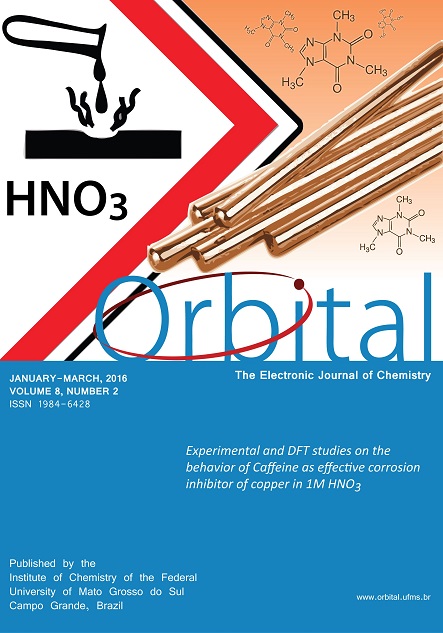Experimental and DFT Studies on the Behavior of Caffeine as Effective Corrosion Inhibitor of Copper in 1M HNO3
- nitric acid,
- caffeine,
- mass loss,
- corrosion inhibition,
- adsorption isotherm
- quantum parameters ...More
Copyright (c) 2016 Orbital: The Electronic Journal of Chemistry

This work is licensed under a Creative Commons Attribution-NonCommercial-NoDerivatives 4.0 International License.
Abstract
Caffeine was tested as copper corrosion inhibitor in 1M HNO3 using mass loss technique at 308-328K and theoretical studies based on quantum chemistry. The inhibition efficiency is concentration and temperature dependent: Caffeine showed an inhibition efficiency of 78% at 5mM for T =328K. The thermodynamic adsorption parameters ( were determined and analyzed. They revealed a spontaneous adsorption process and a strong interaction between Caffeine and the metal surface. Adsorption isotherms including Langmuir, Temkin and El-Awady were tested. It was found that Caffeine adsorbs on copper according to the modified Langmuir adsorption isotherm. The Dubinin Raduskevitch model was used to distinguish between chemisorption and physisorption. Activation parameters ( were also determined and discussed. Furthermore, the quantum chemical properties/descriptors most relevant to the potential action of the molecule as corrosion inhibitor such as highest occupied molecular energy (EHOMO), lowest unoccupied molecular orbital energy (ELUMO), energy gap(∆E), dipole moment ( and charges on heteroatoms were calculated using DFT at B3LYP level with 6-31+G (d) and LanL2DZ basis sets. Fukui indices were also determined and discussed. The theoretical results are consistent with the experimental data reported.

